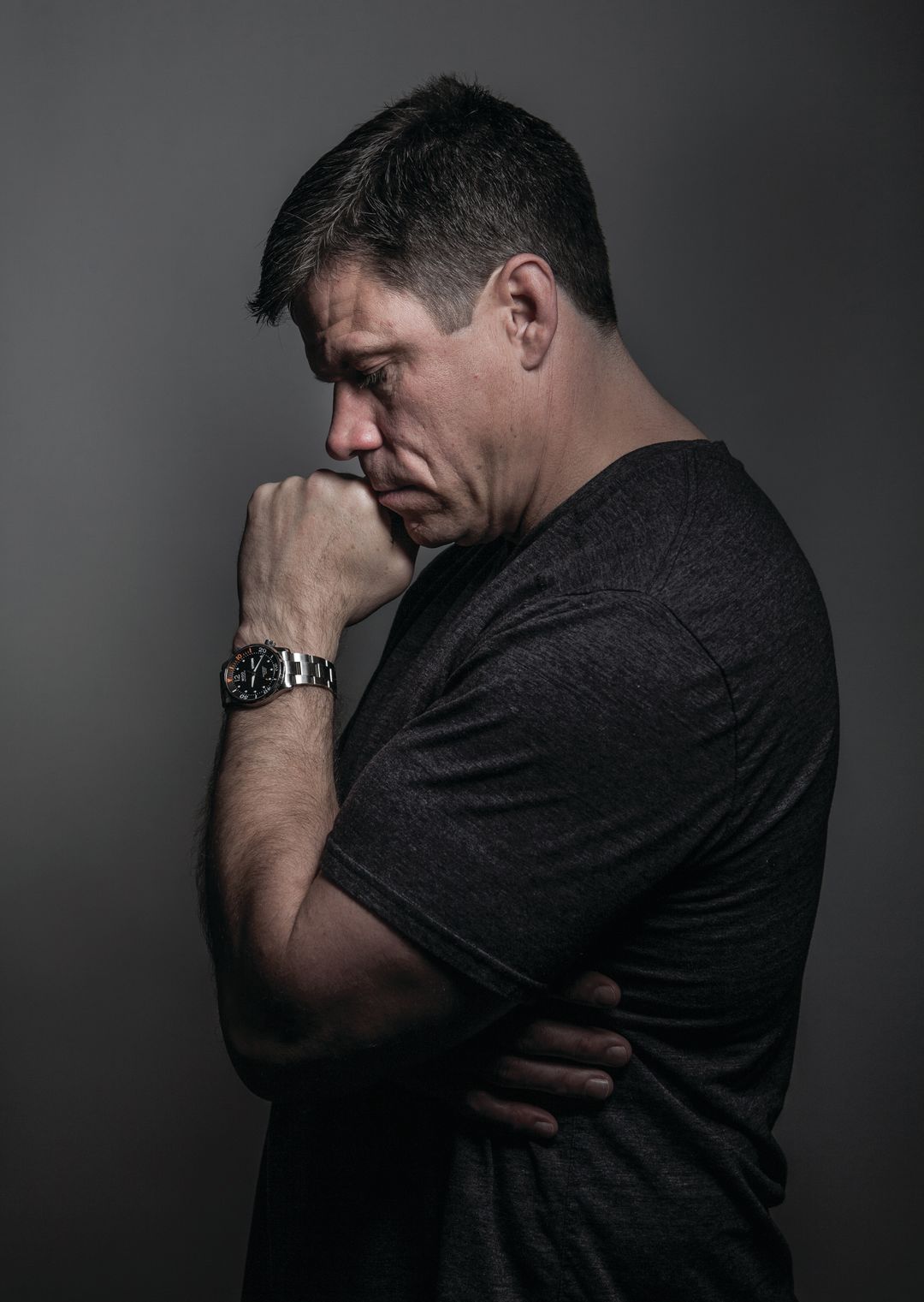Brutal Blows: Life After the NFL—and the Concussions, and the Addictions

Sitting inside the sunlit studios of KILT-AM, Ted Johnson is listening to a recent UH grad discuss his chances in the upcoming NFL draft. Reaching past his superhero jaw to remove an earbud, he turns to a visitor and says, “Can you hear this guy? I’m impressed.”
Johnson’s approval carries weight. The current Houstonian and former New England Patriots linebacker—winner of three Super Bowls—is revered among Boston sports fans as one of the ultimate hard-hitting tough guys. “In Boston, the pro athletes are celebrities,” he says, “and they appreciate the blue-collar guys.”
Retired pros like Johnson, 43, often find homes in sports media, and in a football-obsessed state like Texas, ex-NFL heroes come at a premium. Today Johnson co-hosts KILT’s afternoon show, The Triple Threat. His radio cohorts call him Teddy Three Rings.
Yet only a few years ago—between 2011 and 2013—Johnson, broke and recovering from a drug addiction, was living in Tomball with his dad and stepmom, bussing tables and delivering food at their barbecue joint, The Original Rib Tickler. “I went from being a multi-millionaire to nothing,” he says.
He’d retired in 2005 after a decade-long NFL career, the final three years of which were plagued by what he now believes were problems caused by a series of serious concussions he endured while playing. While Johnson’s ferocity on the field made his career, it also was his undoing. During his time in the NFL, he withstood hundreds of violent collisions. The cumulative effects were devastating.
“There was no name to what I had,” he explains today. “When I retired, I just said, ‘Coach, my head hurts.’”
Born in Alameda, California, Johnson moved to Houston when he was 1, living in a small house across from Hobby Airport for the next 12 years, mostly with his mother. Ironically, he wasn’t allowed to play football as a kid; his parents feared he’d injure himself. Long and lanky, he didn’t exactly have the build for it, anyway.
Despite his parents’ attempts to protect him, Johnson developed a passion for the sport as a kid, fostered by frequent trips to the Astrodome. “My love of football started with the Houston Oilers,” he says. “My first number was 34,” a nod to Hall of Fame running back Earl Campbell.
When he was a teenager, Johnson moved back to California with his mother. By then, he says, his home life had turned ugly, so he devoted his attention to sports, including football—parental resistance was no match for his desire to play.
Johnson learned, after his sophomore year, that he’d have to pay his own way through college. It was then that he began to plan his escape. “When my dad told me that, I stopped playing basketball and baseball,” Johnson says. “My junior and senior year, all I did was work out. The only way out for me was football.”
By the end of his junior year, Johnson had landed on the radar of college recruiters. He signed his letter of intent with the University of Colorado as a senior and, within two weeks, literally ran away from home. “I left my car and everything there,” he says. “I ran all the way down to the bottom of the hill, about two miles from where I lived.” (He and his mother remain estranged.)
In 1995, Johnson was drafted in the second round by New England, where he played his entire 10-year career. While he was a good athlete, his greatest asset was his sheer determination and work ethic; he was always a weight-room junkie. With his massive, squared-jawed mug, the 253-pound linebacker became known as Ted the Head to opponents, who feared his brutal blows.
The most memorable crack came in 2003, when Johnson hit Miami Dolphins offensive lineman Jamie Nails so hard that it literally split the man’s helmet in half on the turf. It was an iconic moment, a brutal helmet-to-helmet hit that Johnson still speaks of with pride—a large, framed photo of the shattered piece of equipment remains in his apartment today.
Yet it’s hard not to see the helmet as a symbol of Johnson’s love-hate relationship with the NFL. He doesn’t regret playing professional football. He just wishes he’d known what he was getting into.
It was the same year Johnson retired—2005—that scientists identified the condition known as chronic traumatic encephalopathy (CTE), a repetitive brain-trauma disease not unlike Alzheimer’s that causes depression, headaches, sleeplessness and reduced cognitive function. CTE, research shows, is progressive.
The discovery ignited a firestorm around the NFL that has continued to intensify ever since. How much did the league know about the devastating long-term impact of the disease, and for how long? How many players were affected? Today CTE is the focus of a long list of lawsuits, as well as congressional hearings, media coverage, and even a major studio feature film, Concussion, which came out last year.
Former professional wrestler Chris Nowinski was one of the earliest to speak out about the dangers. A concussion sufferer who founded the Concussion Legacy Foundation (CLF) in 2007 with his doctor, Robert Cantu, Nowinski first met Johnson in 2006. “No one ever explained to him what post-concussion syndrome was or how it could change you,” Nowinski says.
Nowinski introduced Johnson to Cantu, and for the first time, the former linebacker understood the consequences of concussions. One of the cruelties of the disease is that researchers haven’t yet devised a method to diagnose the illness in subjects who are still living. Two years after meeting Nowinski and Cantu, Johnson became the first athlete to agree to donate his brain to science.
“That raised a lot of awareness,” Nowinski explains. “Ted had the guts to make that commitment back in 2008, when it was such a strange idea. Now over a thousand athletes have followed his lead.” And they are some of the most prominent names in sports —not just football—including Olympic soccer star Brandi Chastain and legendary NASCAR driver Dale Earnhardt, Jr.
Yet even today, not all athletes are willing to come forward. Having someone like Johnson—or, as Nowinski calls him, Cement Head Ted—on board has been critical to the success of the CLF. When a guy with Johnson’s reputation discusses his problems, says Nowinksi, it demonstrates to other athletes that they “can be tough and still talk about and respond to the concussion crisis.”

Image: Michael Starghill Jr.
Johnson's issues started in the summer of 2002. During Patriots training camp, he suffered a pair of concussions within the span of four days. “That whole season, I was in a fog,” he says. He’d often forget plays and find himself out of position, uncertain how he got there.
From then on, more concussions followed, with frightening regularity. “My personality was changing,” Johnson says. “I knew that something wasn’t right, but I had never heard of post-concussion syndrome.”
His mental health deteriorated further after he hung up his cleats in 2005. “I wanted to feel cognitively like the guy I always was. I was more withdrawn, and I have a very social personality,” he says. “Then, somebody introduced me to a drug called Adderall.”
Within a year of his retirement, he was an addict, blowing through multiple prescription refills of the drug every month. “The sad part is, that drug helped me,” he says. “But it got out of hand.”
When Johnson couldn’t get the medication he needed, he turned to cocaine. In 2006, he separated from his wife and found himself living at the Ritz-Carlton in Boston, suffering from crippling depression, using drugs, burning through money and doing little else. “I was in a really dark place,” he says. “I’d be in bed for a week and not get up.”
After learning about CTE, in 2007, Johnson gave a bombshell interview to the New York Times, sharing the story of his struggles with depression and addiction and unloading on the Patriots—particularly his former coach Bill Belichick who, he said, ignored the advice of trainers and continued to instruct him to complete dangerous, full-contact workouts. But Johnson's biggest concern, he told the paper, was for current players. He wanted them to be aware of the risks.
Nearly a decade later, some pros are heeding the warnings from Johnson and other former players. A few have shocked fans—and NFL teams—by walking away, sometimes long before reaching their prime. This past April, A.J. Tarpley retired after his second year as a linebacker for the Buffalo Bills, citing the four concussions he’d suffered in college and during his first year in the pros. He was 23 years old.
By 2011, everything Johnson had was gone, and he entered three months of treatment outside of Dallas, partly to be closer to his father and stepmother. It was his fifth stint in rehab, and this time, it finally stuck. He began outpatient treatment in Houston while living with his parents in Tomball and working at The Original Rib Tickler, serving up plates of barbecue at the family restaurant. “I needed to take care of myself,” he explains, “and I was with my dad. My dad is my best friend.”
Johnson’s outspoken honesty led to a bittersweet opportunity. In 2012, NFL defensive great Junior Seau committed suicide, and the following year, his family released the results of his autopsy. As many had suspected, Seau had CTE.
Johnson revered the late player. They’d even worked out one-on-one when Seau was a rookie in the NFL and Johnson still a senior in high school. Devastated, he appeared on prominent sports-talk radio station KILT, giving a raw interview about his own troubled path and his frustration with the NFL for not owning up to its mistakes.
“I think it’s one of the most courageous things I’ve ever seen in our business,” says Rich Lord, who co-hosts the afternoon show with Johnson and Sean Pendergast. “It’s as honest as it gets.”
The disarming way Johnson discussed his own health issues and his indignation over the way the NFL handled concussion protocols—as well as his on-air demeanor—caught the eye of the station’s former general manager, who also happened to be from Boston.
Johnson became a regular, eventually winning a gig co-hosting an evening call-in show. Soon his knowledge and matter-of-fact persona made him a fan favorite. “I was told the more you are willing to share, the more people will relate to you,” he says. “So, I decided the thing for me is, I’m going to be the guy who just puts it out there—I mean, all of it.”
Aside from his unsparing candidness, Johnson has grown into a well-rounded talk show host. Lord, who has worked in sports radio for 35 years, is continually impressed with Johnson’s football acumen. “Honestly, I learn something almost every time we talk about strategy,” he says. “He’s an unending wealth of information.”
Now living near downtown and working on the drive-time show, Johnson seems remarkably at ease with himself and happy with his life. Though there is no known cure or treatment for post-concussion syndrome, doctors believe minimizing stress, staying in shape and keeping yourself mentally sharp can help.
Johnson maintains his health and keeps his addiction in check through careful nutrition and an intense workout regimen. But nothing, he says, is more important than staying busy. “Idle time is the worst thing,” he says. “If I didn’t have a job to go to every day, I’d be in trouble.”
It’s a long way from the gridiron, but these days Johnson has other concerns. In addition to his radio work, he speaks to groups—including rookies for the Texans and other teams—about the dangers of concussions and life in the NFL.
Today, he still has the same intensity that pushed him to fame and fortune in professional football; he’s simply redirected it. “I want to have a compelling life,” he says, “I want to have a meaningful life.”




